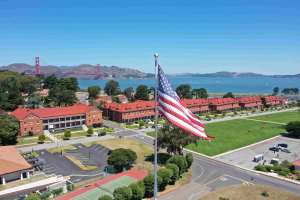Historic Building Rehabilitation Earns LEED Gold Rating
Presidio historic nurses dormitory is first San Francisco building to be Gold certified in LEED-CS

Presidio of San Francisco (May 18, 2010) — In the beginning, skeptics abounded. “It was like you’re either doing an historic building or you’re doing a ‘green’ building but you can’t do both,” says Chandler McCoy, associate director for planning for the Presidio Trust. “We’re showing that you can do both.”
With the rehabilitation of the Public Health Service District historic nurses dormitory, the Trust has moved to the forefront of efforts to apply green building practices to historic buildings. The U.S. Green Building Council has awarded the building a gold certification in the Council’s Leadership in Energy and Environmental Design (LEED), making it the first registered historic building in San Francisco to be gold certified in the LEED-CS category.
“Rehabilitating an historic building is itself a sustainable practice,” adds McCoy. “Even more so than building new, after all, the “greenest” building is one that already exists and is given another 50 years of life.”
LEED is an internationally recognized green building certification system, providing third-party verification that a building or community was designed and built using strategies aimed at improving performance in energy savings, water efficiency, CO2 emissions reduction, improved indoor environmental quality, and stewardship of resources and sensitivity to their impacts. Projects in the Presidio are able to take advantage of existing Trust programs, like the free PresidiGo Shuttle and other programs which encourage alternative transportation; separate parking dedicated to low emission vehicles like hybrids; and green cleaning and pest control systems.
“It is a natural fit for us,” said Craig Middleton, Presidio Trust Executive Director, “Our aim is to transform a centuries-old military post into a national park site distinguished by a track record of using sustainable practices in the redevelopment of historic buildings and infrastructure.”
While the dormitory is the first Trust project to be LEED certified, it won’t stand alone for long. The historic cavalry barracks, rehabilitated in February, is also expected to receive LEED gold certification once its final review is complete. The dormitory and barracks are among eleven projects across the park that the Trust expects to be LEED certified – most of them at the gold level.
“These buildings will break down a lot of barriers — real or imagined — to what can and can’t be done in historic buildings,” says Scott Ward, development project manager for the Trust. “Given our experience on these two projects, you’d have a hard time convincing me that you can’t make an historic building green.”
The projects boast a wide range of “green” features. Among the most striking is the cavalry barracks’ new “living” conference room. Housed in an historic addition to the barracks, which once served as the building’s latrine, the conference room is topped with a “living” roof of succulents. The outside walls are covered with a trellis that will eventually wrap the exterior of the room in plants, helping to provide an efficient and natural form of insulation.
The Archaeology Center, another project being considered for a LEED gold rating, will boast an innovative water reclamation system to recycle water through a series of filtration tanks. Archaeologists use a lot of water as they clean artifacts and sift through soil. The new system is sure to capture the imagination of kids in the center’s education programs and other visitors who will have the chance to see it, and the archaeologists, in action.
The Public Health Service District’s sustainable features combine to make it among the first candidates to be considered for the new LEED category for neighborhood development, LEED ND. The district includes four projects all seeking LEED gold certification or higher, including the nurses dormitory. The adaptive reuse of the Presidio’s largest historic structure into Presidio Landmark by Trust partner, Forest City Development, respectfully restores and modernizes the building into 154 units of rental housing. Forest City is also building the only new construction on the site, Belles Townhomes, which are expected to obtain LEED Platinum certification. It will set a new standard in sustainable living with prototype technology to manage energy use. Planted bio-swales in the district’s parking areas are designed to reduce runoff by retaining and diverting storm water back into the landscape.
Everything that goes into the rehabilitated buildings – carpets, flooring, and countertops, among other things – is made from recycled materials. Approximately 70 percent of the debris removed from the buildings is recycled or otherwise diverted from landfills.
The Presidio has long had green building guidelines. But now, with nearly one-third of the staff in the Planning and Project Management departments being LEED accredited professionals, those guidelines have grown into a more formal program that has been integrated into the Trust’s planning process.
The Presidio Trust was established by the United States Congress in 1996 to administer the Presidio of San Francisco, an urban national park that is part of the Golden Gate National Recreation Area and is located at the base of the Golden Gate Bridge. The areas overseen by the Trust include expansive open space and spectacular views, a 300-acre historic forest, and rare and endangered plants and wildlife. The National Park Service oversees the coastal areas of the Presidio. The park comprises nearly 6 million square feet of buildings, including 469 historic structures that contribute to the Presidio’s status as a National Historic Landmark District.